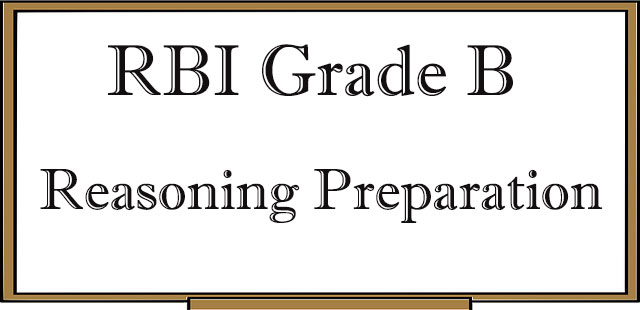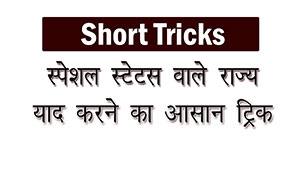-
RBI Grade B Examination - Reasoning Preparation
Updated : 26-Oct-2017
To clear the RBI Grade B Exam you have to plan a strategy to clear the sectional cutoff of the Reasoning section. For this, you should have enough knowledge about the level & pattern of the questions asked in the RBI Grade B Exam.
How to Approach Reasoning Section in RBI Grade B Examination ?
By and large weightage of the Reasoning section is more compared to English and Quantitative analysis section. So, if you are confident and good in solving the questions, you can quite a share of marks in the exam from this itself. Never try to do the guess work in this section. It hampers your performance. Read the questions twice and mark the correct option.
Here are some tips for some topics –
- Syllogism–These types of problems contain 2 or more statements and these statements are followed by the number of conclusions in it. You just have to find which conclusions logically follow from the given statements.
Tips to solve these type of Questions in RBI Grade B Examination
(i) Read the statement very carefully and choose the suitable options which satisfy the given conclusion.
(ii) Try and solve questions with Venn diagram which is an easy method to solve syllogism questions and gives an examiner an holistic view of your knowledge about the questions asked.
Some Important Rules to adhere:
- Possibility in the cases in Syllogism –In possibilities cases, we have to create all possibilities to perceive whether the given conclusion is possible or not. If it is possible and pleases the given statement than given conclusion will follow otherwise conclusion will not follow.
- Restatement is not a conclusion – Conclusion has to be different from the statement, otherwise.
Note: If statement and conclusion are same, then the conclusion does not has to follow. This rule also follows in possibilities case as well.
- Complementary Pairs: (Either & or) – Either and or cases - takes place in complementary pairs only.
How to Solve Syllogism Questions in RBI Grade B Examination ?
Tips & Tricks
- Inequality–It is one of the very easy topics for people who are slightly comfortable with elementary mathematics. These questions are rule-based i.e. certain combinations of statements lead to certain conclusions as well.
Inequalities Golden Rules
(i) The amalgamation between two inequalities can be established if they have a common term.
For ex –
A > B, B > C combination be easily established as: A > B > C. Here we can make conclusion – A > C or C < A
(ii) The combination between two inequalities cannot be established if they don’t have a common term for it.
For ex – A > B, B < C combination will not be established. (Therefore, relationship between A & C cannot be established.)
(iii) Complementary Pairs: (Either & or) – Either and or cases, only takes place in complementary pairs. We shall not combine two elements with common elements in which no relation is established.
For e.g.
Statement: A >B < C
Conclusion: I A > C II. A < C
Here we shall not establish the relation between A and C. We can only draw conclusion to it - i.e. A is either greater than or equal to C or we can say A is either smaller than C to it.
- Coding Decoding–In the Exam - it is expected from you that Mixed Letter Coding types of questions can be asked in the exam.
Mixed letter coding type of questions, three or four complete messages are given in the coded language and the code for a particular word is asked to solve.
(i) To analyze such codes, any two messages bearing a common syllable are picked up.
(ii) The common code word will mean that word particularly.
(iii) By Proceeding similarly - picking up all possible combinations of 2’s, the entire message can be analyzed in a altogether different manner.
How to Solve Coding – Decoding? Concept & Tips
- Seating Arrangement (Circular)– In the exam, it is expected that Sitting arrangement questions can be asked in the following form -
Sitting Arrangement – Inward-Outward
- Linear Seating Arrangement – In linear (row) arrangement problems, we must have to arrange the data linearly. The arrangement is done only in one “axis” and hence, the position of people or objects assumes importance in terms of order like first position, second position, and last position. In this type of arrangement, we take the directions according to our left and right.
Tips & Strategy to score marks in Reasoning Section – In order to be very successful in this section, all you need to do is to know where to focus on three important aspects during the exam:
- Carefully Choose the right questions -It is quite important to select the right questions during the exam. This depends on your regular practice of the problems. Selecting right question not only saves your time but encourages your confidence level during the exam. Solve the questions in which you are comfortable which makes you more confident about them. This will make you mentally prepared to handle tough questions as well. The speed and accuracy in the exam depends on a lot of questions you attempt first in exam.
- Attempt Questions with maximum Accuracy - Don’t just only focus on the number of attempts but also Mark those which you are sure of. It makes a huge difference and gives you more clarity on how you are going to score in exam. When you Attempt questions with accuracy, it will increase the chances of scoring high and will help you to clear the sectional cutoff.
- Time Management– Time management is very important in an online exam, rather I will say it is key towards scoring good marks as well in life. Manage your time wisely and sane fully. It is preferable and always advised to devote 40 or 45 minutes in Reasoning section and try to attempt each question in less than 10 to 15 seconds. This will give you an extra edge on time for the most difficult questions that come later in exam.














